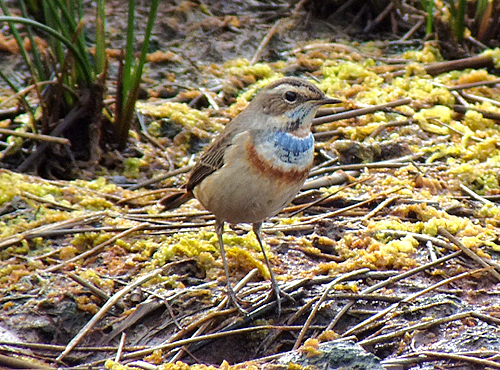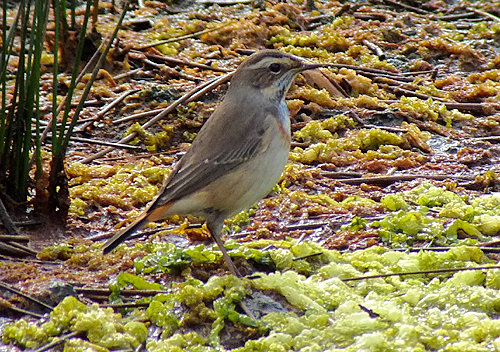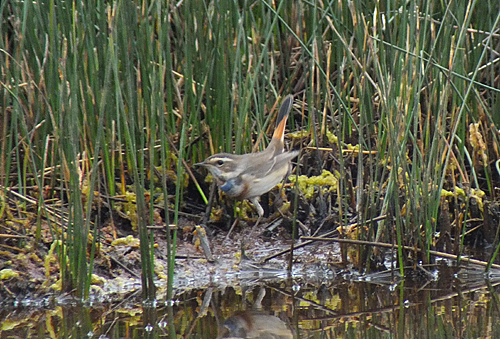- Home
- FAQs
- Customer Video Gallery
- Customer Photo Gallery
- Bird Facts
- Bird Food Blog
- Bird Information
- Feeding Advice
- Small Animal Information
- A to Z of Guinea Pigs
- A to Z of Hamsters
- A to Z of Rabbits
- Basic Care for Guinea Pigs
- Basic Care for Hamsters
- Basic Care for Rabbits
- Basic care for Chinchillas
- Basic care for Ferrets
- Basic care for Gerbils
- Basic care for Mice
- Basic care for Rats
- Buying a Healthy Small Animal
- Does your Reptile need a Licence
- Equipment for Ferrets
- Equipment for Hamsters
- Equipment for Mice
- Equipment for your Chinchilla
- Equipment for your Gerbil
- Equipment for your Guinea Pig
- Equipment for your Rabbit
- Keeping a House Rabbit
- Dog Information
- Cat Information
- Customer Information
- Fat Balls
- Suet Pellets
- Straights
- Seed Mixes
- Suet Treats
- Mealworms
- Bird Feeders
- My Account
Bluethroats
Date: 2014-05-13 11:32:52 | Category: Bird Watching | Author: Neill Hunt
Every time I head out to the local patch at this time of year, I hope and dream of finding something a little unusual……a Hoopoe…a Red-backed Shrike….a Bluethroat, nothing too rare and all possible!I look at my patch and due to the variety of habitats within it, any of the above mentioned birds could quite easily find a resting place there for a day or two. The problem as always is ‘if’ and ‘when’?

The other difficulties in finding the rarer birds is the amount of time spent in the field, as a friend of mine says, “If you don’t go out, you won’t see nowt”, of course this if perfectly true, but, many times I do go out and still see nowt!!!
Is the art of finding rarer birds purely down to luck, surely not? The more time you spend in the field must improve your chances of finding the bird on the one day it’s on your patch.
You also need to be at the particular location the bird is at, (you don’t know this location) at the same time the bird is visible or singing. You then need to be able to identify the bird before it dives back into cover and disappears, possibly forever? There are many factors that make bird finding a challenge and I suppose that’s why birding is such a great hobby.
It’s all about being in the right place at the right time!
So if you are looking for a particular bird (that may never turn up) on your patch, here are my tips….
Know the common species………….then,
Know your subject.
What type of habitat does it prefer?
When is it most likely to turn up?
What’s its plumage, in males and females?
Whats its habits?
Whats the call / song?
What weather is more likely to bring one to your patch?
So with that in mind here is my homework on the Bluethroat, There have been about a dozen in Lancashire of which I have seen 3 so I know they occur locally from time to time.
Spring records are the majority and May is the peak month.
They can occur in any county, so please have a read and do your best!
The Bluethroat is a Robin size chat that frequents damp habitats from flooded meadows and damp decaying woodland pools to marshland and reedbeds.
Bluethroats can be skulking in their habits so patience may be required to get a good view.

Adult male.
Bluethroats are small birds, around 13 cm.
Tail is very dark, with bright rusty red base.
The upperparts are uniform olive brown from the rump upwards.
Black eye and black bill.
Wings are also uniform olive-brown often held low in a drooping position.
The most obvious feature is the prominent bright white supercilium and a blue throat, bordered by a black, white and rust coloured band.
2 races occur, red spot and white spot and refers to the central spot on their chest, it a geographical variation.(Northern Europe red, Eastern, white)
Bill, legs and eye black.
Underparts are white.
Females are paler, ghosting the male. They have a white Supercililium, white moustache, the throat markings are variable but normally shows a pale throat and dark spotted breast band, older females may show some blue.
Juveniles appear from April onwards (on the continent) and are very similar to adult females
Bill and eye black, legs often paler.
Song often starts with 4 or 5 high pitched “zee’s” then sounds similar to a Robin / Song Thrush with some mimicry.
Call note is a rather harsh ‘clack’ and a whistled Redstart like ‘huieet’.
So there you have it, all the ammunition you need to find va Bluethroat…….
Happy Birding and good luck!!

I took these photo’s on Scilly last year.




